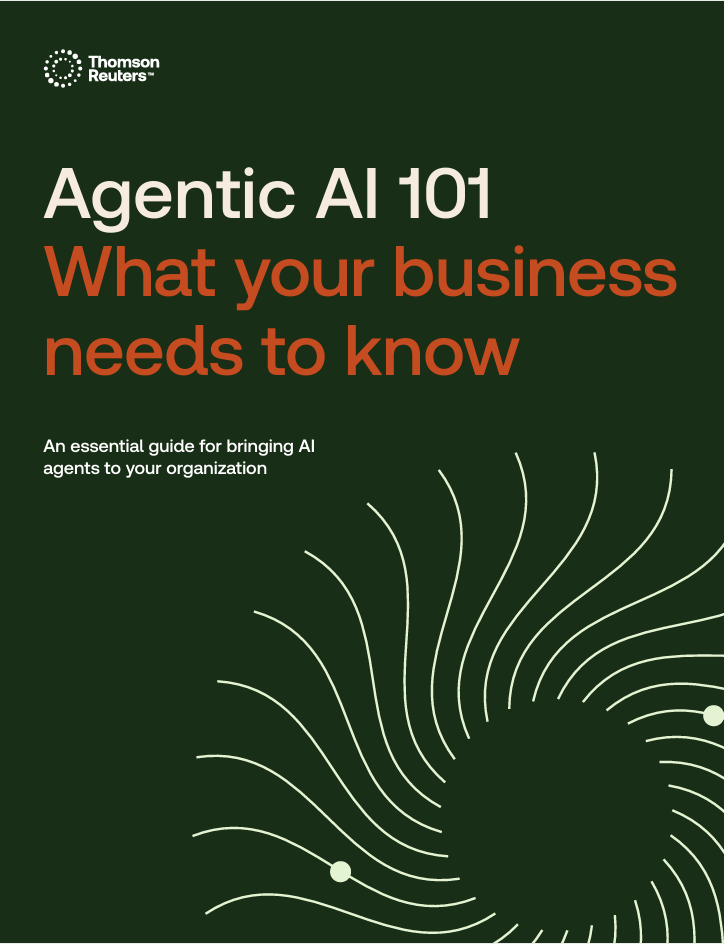The strategies behind AI-driven innovation in modern legal practice
Highlights
- Agentic AI systems advance beyond traditional legal AI by using a controller-coordinator architecture to manage specialized sub-agents, enabling dynamic, multi-step planning for complex legal tasks like case analysis and litigation strategy.
- Training these systems requires proprietary datasets that codify the nuanced steps of professional legal reasoning, while sophisticated evaluation methods test for true comprehension over simple pattern matching.
- Building trust requires interactive, human-centered workflows that help professionals navigate AI's uneven capabilities and acknowledge its limitations in empathy, ensuring the human-in-the-loop remains central to legal practice.
Change is accelerating across the legal profession, reshaping how attorneys approach their work. While traditional AI tools have offered improvements in document review and basic research, agentic AI systems represent a quantum leap.
These sophisticated networks of specialized agents can reason through complex legal problems, plan multi-step strategies, and collaborate with human professionals in ways that mirror how experienced legal teams actually work.
For legal leaders navigating this evolution, understanding how these systems operate isn’t just technical curiosity, it’s strategic necessity. The firms and departments that master the integration of agentic AI will gain decisive advantages in case analysis, litigation strategy, and client service delivery.
In part two of this three-part blog series on agentic AI, we interviewed our resident AI expert, Frank Schilder, senior director of applied research in Thomson Reuters Labs, to provide you with insights into how agentic AI systems think, learn, and collaborate with legal professionals — including their:
- Advanced architecture
- Training methods
- Multi-step planning capabilities
- Trust-building strategies
- The importance of integrating human expertise and judgment into legal workflows
Jump to ↓
The anatomy of agentic AI: Controllers, sub-agents, and legal reasoning
Training AI on nuanced professional judgment and case law patterns
Multi-step planning for litigation strategy and legal research
Trust-building through transparency and interactive review
Professional expertise levels and AI capability mapping
Long-term limitations: Empathy, world modeling, and human connection
Preparing legal teams for the agentic transformation
The anatomy of agentic AI: Controllers, sub-agents, and legal reasoning
Unlike the chatbots that have defined legal AI to date, agentic systems operate through sophisticated architectures that mirror human professional collaboration. At their core lies what experts call a controller or coordinator — a system that analyzes complex requests and orchestrates responses across multiple specialized components.
“An agentic AI system is often steered by a controller or coordinator that analyzes the query or request and creates a plan that identifies the different steps needed to solve it,” explains Schilder. “This allows for more flexibility and adaptability in handling complex problems.”
Consider how this differs from current legal technology. Traditional rule-based systems follow predetermined pathways — if X, then Y. Decision trees split problems into discrete branches but struggle with the continuous uncertainty that defines legal work. Agentic systems, by contrast, create dynamic plans based on the specific nuances of each case.
“For example, an agentic AI system might be tasked with analyzing a legal case and identifying the key issues and relevant laws. The controller would create a plan that involves calling on specialized LLMs to analyze the facts, identify the applicable laws, and generate potential arguments for each side of the case,” he notes.
This architectural approach enhances how legal teams handle complex matters. Instead of manually coordinating among research specialists, brief writers, and strategy advisors, the system orchestrates these functions automatically while maintaining the sophisticated reasoning that complex legal work demands.
Training AI on nuanced professional judgment and case law patterns
The challenge of translating legal reasoning into algorithmic logic has long been considered insurmountable. How do you teach a machine to navigate the subtle interplay among statutory interpretation, precedent analysis, and factual application that defines experienced legal judgment?
The breakthrough lies in training methodologies that go far beyond feeding systems raw legal text. “To translate nuanced professional judgment, such as legal reasoning, into algorithmic logic, we develop training data sets that reflect the legal reasoning steps a lawyer would use in their work,” Schilder reveals.
This approach recognizes that while publicly available legal documents provide foundational knowledge, they often lack the explicit reasoning processes that experienced attorneys use. The solution involves proprietary training data that captures these reasoning steps in detail.
“Publicly available legal text provides a foundation for our models, but it may lack specific definitions and understanding of current law. To address this, we supplement this publicly available legal data with proprietary data that provides more specific details on legal reasoning processes,” he explains.
The evaluation of these systems proves equally sophisticated. Rather than relying solely on standardized benchmarks, developers create domain-specific assessment tools that test AI performance against real-world legal challenges.
One particularly innovative approach involves using case law documents where judges referenced precedent cases, then removing textual clues to create challenging evaluation scenarios that test true understanding rather than pattern matching. “By dropping textual clues (e.g., cf. or contra), we created a recent dataset that is challenging for current LLMs to identify,” Schilder adds.
Multi-step planning for litigation strategy and legal research
The implications for litigation strategy are significant. Where current AI tools excel at discrete tasks like document review, citation checking, and basic research, agentic systems can orchestrate comprehensive analytical workflows that mirror the way lawyers think.
“The ability of agentic AI systems to come up with complex multi-step plans that can address complex problems going beyond straightforward LLM calls is a major advantage over traditional rule-based or decision-tree systems,” notes Schilder. “This allows for more effective handling of uncertain or dynamic situations and enables the system to handle requests even when a tool or specialist is not available at some point in time.”
This capability shifts legal research from a linear process into a dynamic investigation. The system will get increasingly better at simultaneously analyzing factual patterns, researching applicable law, identifying potential counterarguments, and developing strategic recommendations, all while maintaining the logical coherence that complex legal matters require.
Trust-building through transparency and interactive review
However, the most sophisticated AI system remains worthless without attorney trust and effective integration into professional workflows. The key lies in understanding what experts call the “jagged technological frontier,” the phenomenon where AI systems can handle complex tasks perfectly while struggling with seemingly simple ones.
“LLMs are very good at producing and summarizing text, answering complex PhD-level questions, and even generating creative content. However, they may be unable to provide the correct answer to simple tasks such as counting the number of ‘r’s in a word like ‘strawberry’ or understanding nuances of human language,” Schilder observes.
This reality demands interactive workflows that allow legal professionals to navigate AI capabilities intelligently. “To ensure trust and usability at the point of handoff, it’s essential to interactively generate and review responses from an AI system,” he emphasizes.
Professional expertise levels and AI capability mapping
The integration challenge varies significantly based on professional experience levels. Senior partners may quickly identify AI errors in complex legal analysis, while junior associates might need more guidance in evaluating AI-generated work.
“Since every human interacting with an AI-based system has different levels of expertise, it’s essential to provide support and guidance for those who may need more time and assistance to navigate the jagged frontier,” Schilder notes. “Experts in a particular field may be able to quickly identify inaccuracies in the output of an LLM, while junior professionals may require more training and mentorship.”
This recognition requires differentiated training approaches and workflow designs that account for varying expertise levels while maintaining quality control across all interactions.
Long-term limitations: Empathy, world modeling, and human connection
Looking ahead five years, the capabilities will be groundbreaking. “I expect agentic AI to revolutionize industries such as healthcare, finance, and law by enabling complex tasks like scientific discovery, litigation strategy analysis, and creative problem-solving,” Schilder predicts.
We’re likely to see multi-agent systems collaborating on complex tasks, from designing new materials to developing medical treatments, much like Grok 4 heavy has demonstrated by using coordinated agents to solve challenging problems.
Achieving these breakthroughs will require ongoing advances in hardware, more sophisticated models, and close interaction with human experts to make novel connections. As a result, agentic workflows will become commonplace across both consumer and professional applications, streamlining everything from booking travel and comparing products to writing software and crafting legal arguments.
Yet fundamental limitations remain. “One area where we’re still struggling is in representing a world model and empathizing with other humans,” he acknowledges. “Empathy is a fundamental aspect of human behavior and decision-making, and it’s essential for building trust and understanding between humans and machines.”
This reality emphasizes why successful AI integration must be human-centered. “The deeply human capability will be difficult to automate and hence the human-in-the-loop or better the product workflow needs to be designed to keep the human need and purpose at the center,” Schilder concludes.
Preparing legal teams for the agentic transformation
The message for legal leaders is clear: agentic AI represents not just technological evolution but professional advancement. The firms and departments that understand these systems’ capabilities and limitations, and design workflows that leverage both AI efficiency and irreplaceable human judgment, will define the future of legal practice.
The question isn’t whether agentic AI will redefine legal work, but whether your organization will lead or follow that evolution. To learn more about agentic AI and how it can help legal professionals optimize their workflow, watch our webinar on demand.
















